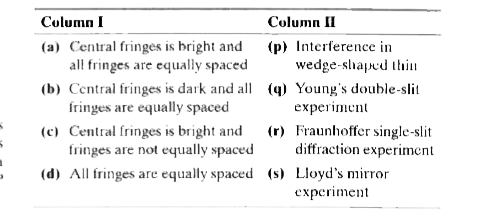Text Solution
Verified by Experts
Topper's Solved these Questions
INTERFERENCE AND DIFFRACTION
RESNICK AND HALLIDAY|Exercise PRACTICE QUESTIONS (Integer Type)|6 VideosINTERFERENCE AND DIFFRACTION
RESNICK AND HALLIDAY|Exercise PRACTICE QUESTIONS (Matrix-Match)|1 VideosHYDROGEN ATOM
RESNICK AND HALLIDAY|Exercise PRACTICE QUESTIONS(Integer Type)|6 VideosMAGNETIC FIELDS DUE TO CURRENTS
RESNICK AND HALLIDAY|Exercise Practice Question (Integer Type)|4 Videos
Similar Questions
Explore conceptually related problems
RESNICK AND HALLIDAY-INTERFERENCE AND DIFFRACTION -PRACTICE QUESTIONS
- Match the statements in Column I labeled as (a), (b), (c), and (d) wi...
Text Solution
|
- Interference is an important property of light. In the given table, C...
Text Solution
|
- Interference is an important property of light. In the given table, C...
Text Solution
|
- Interference is an important property of light. In the given table, C...
Text Solution
|
- The amplitudes of two coherent waves are vector quanti- ties. In the ...
Text Solution
|
- The amplitudes of two coherent waves are vector quanti- ties. In the ...
Text Solution
|
- The amplitudes of two coherent waves are vector quanti- ties. In the ...
Text Solution
|
